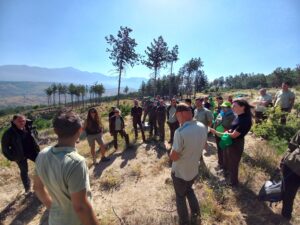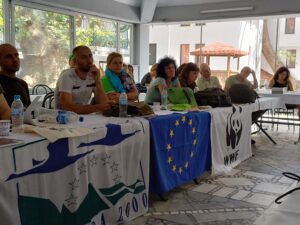Climate change and related natural disturbances are one of the most significant challenges facing forests. Experts warn there is uncertainty about how forests will cope with projected higher temperatures and summer droughts in the coming decades. One of the regions in Bulgaria where the most serious changes are expected is Southwestern Bulgaria – according to climate models, it is very likely that a Mediterranean-type climate will occur with a significant increase in temperatures.
In order to raise awareness of the topic, on 6-7 July WWF-Bulgaria held two workshops on the topic “Natural disturbances in the forests”, in which representatives of various forestry institutions in the country took part.
Bushfires
With the onset of the bushfire season and worrying statistics in recent years, special attention has been paid to bushfires. Scientists, forestry officers and environmentalists discussed the increase in the frequency of bushfires, shared good practices for dealing with their consequences, as well as the usage of GIS-systems to predict the probability of occurrence and spread of bushfires.
The first workshop was held on the territory of the Southwestern State Forestry Enterprise (SWSFE). It was attended by representatives of 13 Forestry Management Units and Regional Forestry Directorate “Blagoevgrad”. The venue of the event was the “Kresna” Forest Management Unit, which was not chosen by chance: in 2017, one of the largest bushfires in Bulgaria broke out there, which affected huge areas of Scots pine (Pinus sylvestris) crops, Downy oak (Quercus pubescens) forests, as well as the very rare species Greek juniper (Juniperus excelsa). The employees from the Management Unit, together with representatives of the Forestry University, WWF and SWSFE visited the burnt and already restored places.
The participants were familiarized with the specifics of the area, the problems encountered there, as well as with the different approaches to the restoration of the burned habitats undertaken by the employees of the „Kresna“ State Forest Service. The affected areas are forested with various tree species, including Scots pine, bog pine (Pinus mugo), Greek juniper and oaks. Greater species diversity is a prerequisite for determining which species will be more resilient in the face of a changing climate.
The consequences of climate change
Both workshops focused on the context of the increasingly evident consequences of climate change. Projections of a change in the frequency of droughts were considered, as well as an expected increase in temperatures. However, the combination of them increases the potential to affect forsests and therefore forest ecosystems.
According to associate professor Dr. Momchil Panayotov, more intense and more frequent extreme weather events are expected, such as strong storms with torrential rainfall, heat waves, droughts. They have the potential to have a more serious effect than the “slow changes” of climate to which ecosystems are able to adapt. Recently, we have been witnessing phenomena that we classify as “unusual” in terms of their intensity, period of occurrence, etc., such as: frequent and intense heat waves, long periods without precipitation in summer, strong storms, icings in winter and many others. In recent years, this has necessitated a drastic increase in “forced sanitary logging” due to significant damage from wind gusts, bark-beetles attacks, fungal pests, etc.
As possible solutions to deal with the consequences of natural disturbances, those that support the diversification of the structure of forests such as species, age and genetics stand out. WWF experts also remind that it is extremely important to preserve old forests, areas and individual trees, which are valuable for preserving the sustainability of habitats and biodiversity.
Reaction in critical situations
Participants in the workshops are aware of the need for capacity to act when critical situations arise – improvement of problem detection systems (eg. fire towers), availability of qualitative information systems and resource for data analysis, as well as equipment and training, necessary for an adequate response. During the workshops, modern ways of modeling the probability of occurrence of forest fires for specific areas were presented. With the help of GIS-systems, satellite, meteorological and other data, maps of the most risky areas are prepared, and it is even possible to predict the likely area and direction of spread of forest fires. With the help of these modeling systems, the potential damage that could be caused to people and to cultural and natural values is also assessed.
Experts agree that active efforts should also be made to support species that are considered to be at greater risk.
Scots pine (Pinus sylvestris) forests in the context of climate change
During the workshops, the issue of ecosystem fit of Scots pine plantations was also raised.
Predominantly, these afforestations were made outside the natural range of distribution. Their shortcomings become apparent after the trees reach 20-30 years of age, namely their health deteriorates and they become susceptible to the influence of various biotic and abiotic factors. Currently, these forests are at an age where degradation is observed and adequate measures must be taken for their management. These are anthropogenic ecosystems and the processes that take place in them differ from the processes that take place in the natural ecosystems, reminds Dr. Toma Tonchev from the Forestry University. This is exactly what requires their management in a different way, and over the years, numerous studies have been done on their condition, productivity, sustainability and ecological compatibility.
One of the factors that has a particularly strong influence on the condition of these conifer plantations is moisture, the negative effect of which is expressed even more clearly with the increase of droughts. Another problem was inherent in their creation, namely that these forests are very densely forested. The lack of of adequate care slows the growth of trees and reduces their overall resilience, while at the same time increasing vulnerability to abiotic and biotic damage and desiccation. In turn, reduced resilience leads to additional risks of fires and calamities.
Adaptation to climate change and resistance to natural disturbances of these vulnerable Scots pine crops is also a priority of the project “Climate-Smart Forest Management for Central and Eastern Europe”, co-financed by the EU’s LIFE program, as part of which WWF held the workshops. Its main goal is to gradually transform these forests into ones with a diverse species and age structure, by stimulating the development of natural deciduous vegetation, which will also increase their overall resilience and health.









